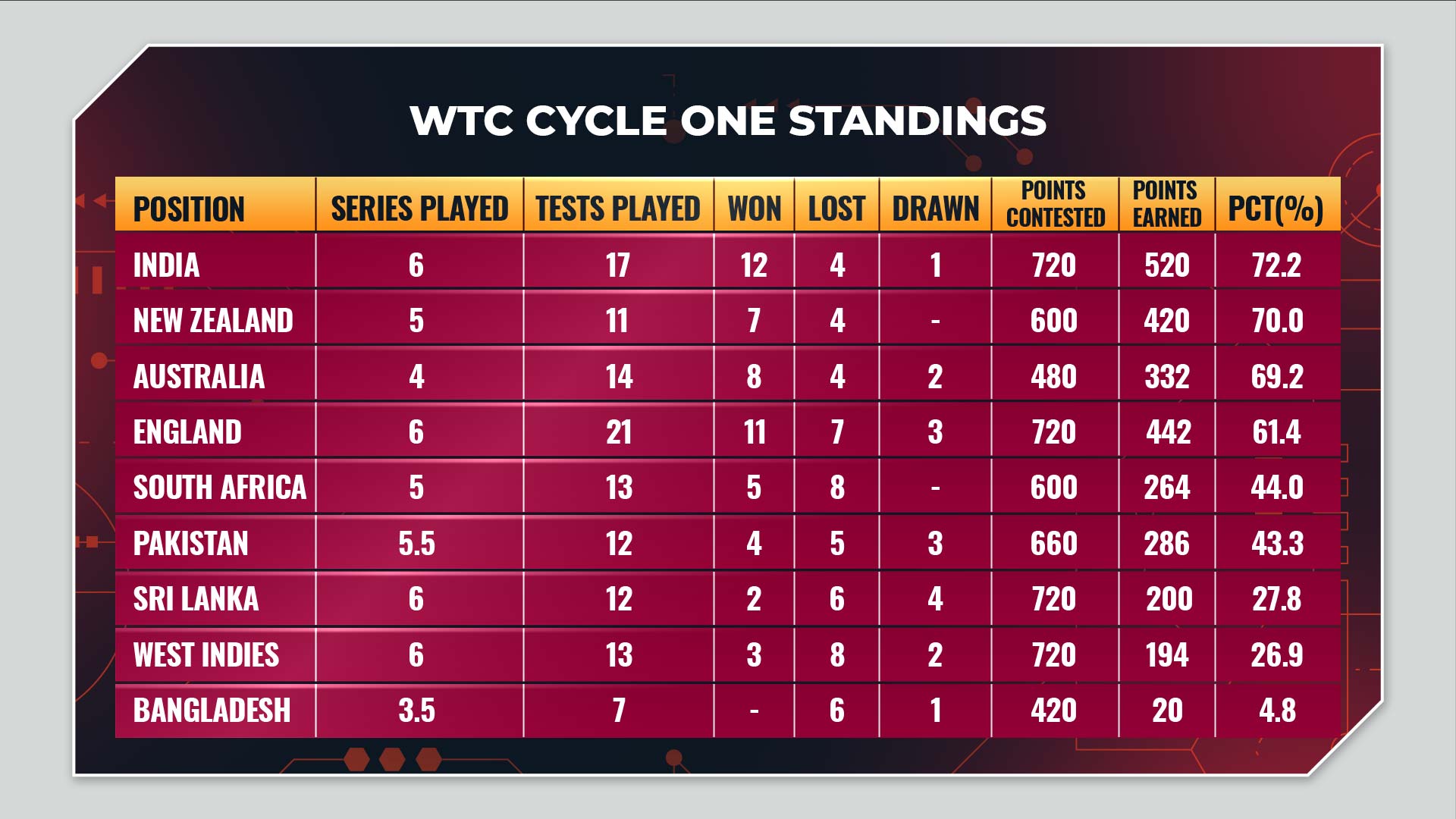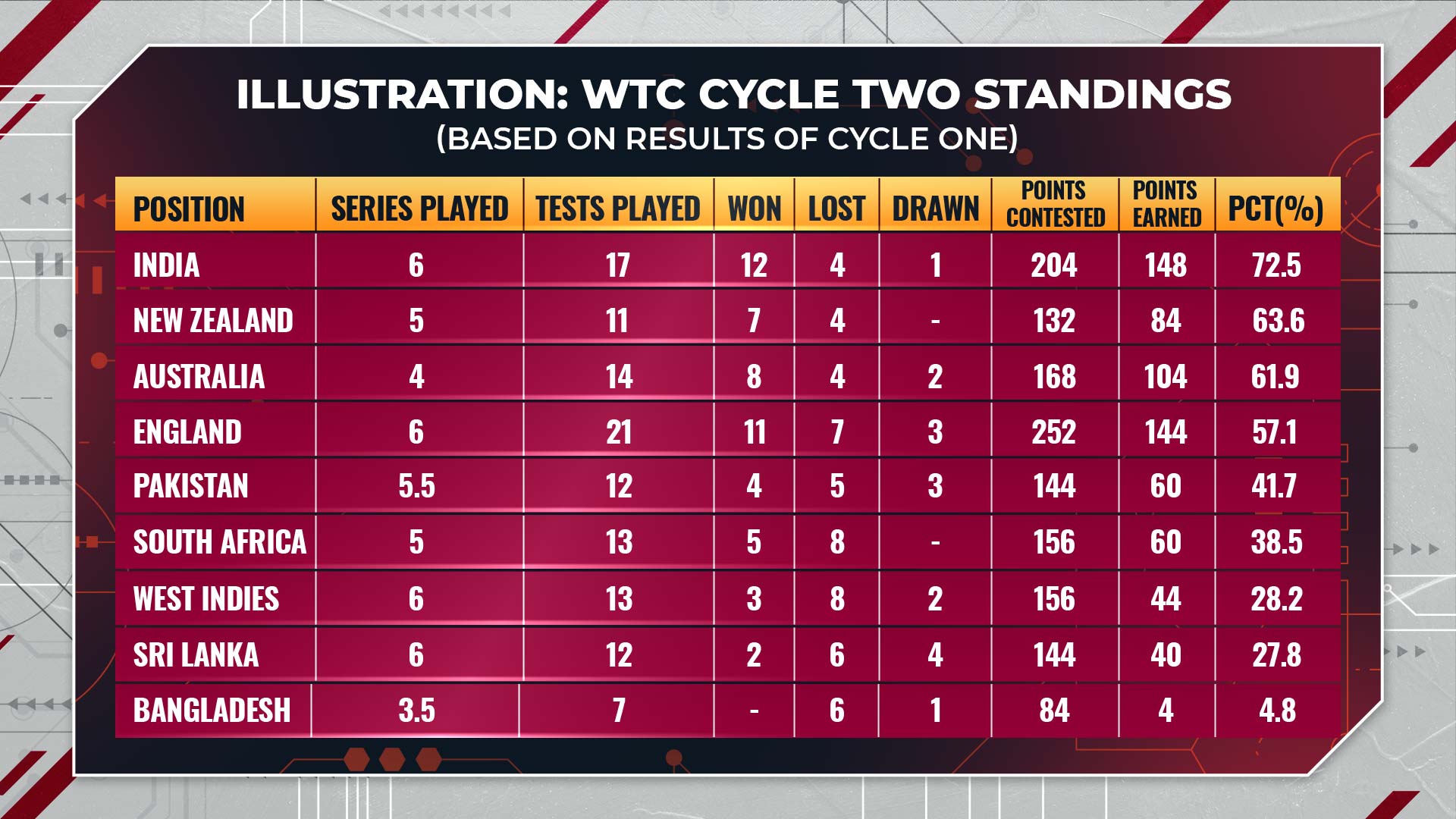News
Decoded: World Test Championship Cycle Two
 FEATURE
FEATUREWhat does the new points system imply? Which team has the easiest route to the final?
The aim of the World Test Championship was to put Test cricket back on the cricketing map. While the actual cycle did not gather momentum owing to a lot of factors like a convoluted point system, cancellation of fixtures due to the pandemic and subsequent change in methodology, all eyes were on the first-ever final. In a way, it did work wonders for the health of cricket that the nation which does not has cricket as its primary sport managed to lift the trophy. New Zealand’s win might not only propel kids from that country to think of cricket as a career option but can also add as fuel to drive the cricket nations outside the Big Three to achieve greater things.
India’s tour to England starting the 4th of August 2021 will mark the beginning of the second WTC cycle. While the overarching concept remains the same with nine participating nations, each playing three home and three away series, there is a change in the points system. First up, let us look at the number of Tests that each side will be playing in the second cycle.

Just like the previous cycle, England will play the most number of Tests. They are also the only side that will play two five-Test series, one each with India and Australia. Apart from playing England, India and Australia will play each other in a four-Test series. All the other series will either be a three-match or a two-match series.
From the first look, Australia look like the team with an advantage since they will play a higher proportion of home Tests than any other side. This might not have mattered during the first cycle. But, it will in the second cycle that has an updated points system.
Updated Points System
The biggest change in the points system in the second cycle is the shift from having every series with the same number of points (120) to every Test holding the same number of points (12). Does it change a lot in terms of how the first cycle panned out? Maybe, we will check it a little later. But it does ensure the points system is really easy to understand for everyone.
In the first cycle, there were 120 points up for grabs in each series. This resulted in each Test played for different points depending on the number of Tests in the series. A Test in a 5-match series was worth 24 points, that in a 4-match series 30, 40 points for a Test in a 3-Test series and 60 for a two-Test series. Points available for a draw were 30% of that for a win. All in all, complications at every step. In the end, by looking at the points table it was impossible for someone to understand how the points were calculated.
For the second cycle, ICC have changed the system to have each Test worth 12 points. Hence, no matter how many Tests there are in a series, every Test will be worth the same points. Similarly, a draw will give 4 points whereas a tie will be worth 6. In this cycle, one will be able to easily understand the points after looking at the table.
Now, in the first cycle, the pandemic led to the cancellation of some fixtures. This resulted in a mid-cycle change to the points system. The disruption led to an alternate methodology: PCT. This stands for the ratio between points earned and points contested for. Taking New Zealand for example, since they played five series, they contested for 600 points based on the old system. Since they earned 420 of those, their PCT was 70%.
For the second cycle, the PCT methodology remains intact in which the final tally will depend on the percentage of points earned. This implies England will be playing for 264 points whereas Bangladesh will be playing for 144. But, it will not matter as the final ranking will depend on the percentage of points earned by a team and not the total points.
Now let us understand what changes with respect to the method in the previous cycle. This is how the league table of the first cycle finally looked like-

Unless and until one is aware of how many Tests were there in each of the series played, it would have been difficult to know the total points earned just by looking at the table. Now let us superimpose the same number of series and Tests played along with their results in the updated points system

In the new format, it is fairly simple to understand the points earned which are each win times 12 and each draw times 4. Note the subtle changes in the final PCT. Due to India’s superior win percentage, the gulf between them and New Zealand would have been bigger if this system was in place in the first cycle.
Also, with the new system, New Zealand would have finished above Australia even without them losing points due to a slow over-rate. Just to refresh your memory, Australia lost four points due to a slow over-rate in the Test against India at the MCG. If not for that, they would have finished with the same PCT as New Zealand and the ranking would have been decided through runs per wicket ratio during the cycle which was superior for Australia. Yes, for all those still hungover on the 2019 World Cup final, teams clashing on PCT will have their ranks decided on a higher runs per wicket.
In the earlier system, the incentive for a side to win a dead rubber of a five-Test series was a lot less. In this cycle, every Test will matter equally and hence will reward the teams with a higher win or a low loss percentage.
Coming back to the rules on deduction of points due to slow over rates. The previous cycle has two points deducted for every over lost. That has been updated to one point per over. Owing to a decrease in overall points per Test, the over-rate penalty can have a bigger say in this cycle. Like the penalty for Australia from the previous cycle can affect their PCT by 1.2 points as opposed to 0.8 points in the first cycle. Small difference but we are talking about fine margins here.
The Fixtures
Getting to the crux of the matter. This is what each side will be up against during the second WTC cycle-

While it will be foolhardy to speculate on how things will progress but let us forecast the difficulty level of the route to the final for some sides.
WTC cycle will always hold an advantage for sides who are dominant at home. This is precisely why India and New Zealand made it to the finals in the first cycle. And it is why England, with their home conditions favoring a lot of other teams, might struggle this time around too.
The variable for each side will be the quality of their away oppositions. One team that could not have asked for a better route on this front are Pakistan. Two of their away oppositions are Sri Lanka and Bangladesh. The two not so strong teams with conditions suiting the Pakistan batsmen. Their third away series is against the West Indies which Pakistan can dominate as well. They are the only side without an away series that really stands out on difficulty level. If their spinners can trump Australia, England and New Zealand at home, they would fancy their chances of making it to the final.
India have one difficult away fixture which is first up against England. An advantage here would be that given it involves five matches, even if India doesn’t win it as a series, they would fancy registering a win or two.
With that out of the way early on, India can steer the ship for the rest of the fixtures as needed. South Africa is in a transition phase and hence India might conquer that final frontier. Their home series against Australia should ultimately decide their prospects.
Australia and New Zealand have tough away fixtures against India and Pakistan to counter. Australia have Sri Lanka to worry about as well. The last they won a series in the subcontinent was 2011.
Lastly, England need a lot of things to go their way again. Home series against India will be a tough challenge and the Ashes in Australia will be tougher. New Zealand beat them at home recently and they will have to face them again in 2022. A tour to Pakistan will not be easy either.
So if you are someone from 90s or earlier and hoping to see India and Pakistan engage in a Test, this WTC cycle might just make your wish come true.